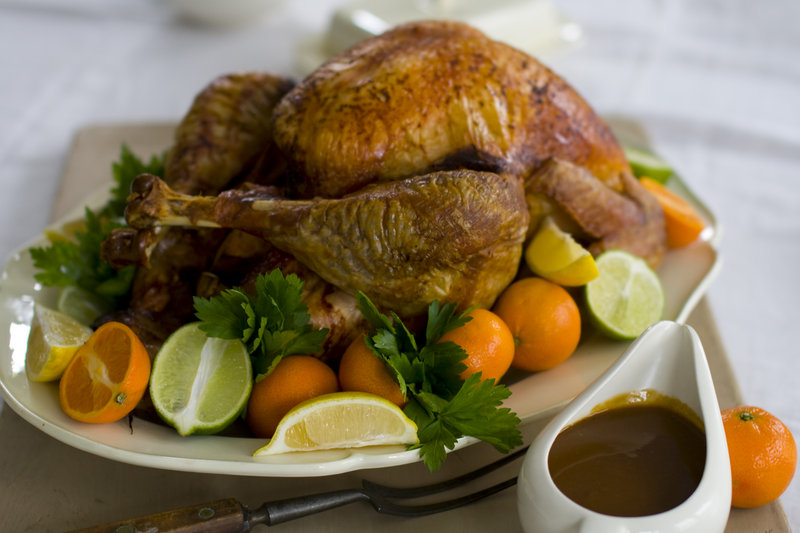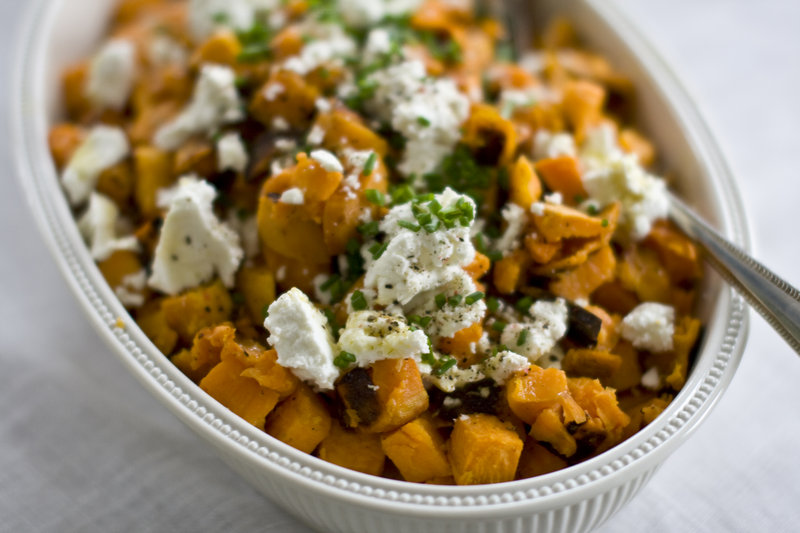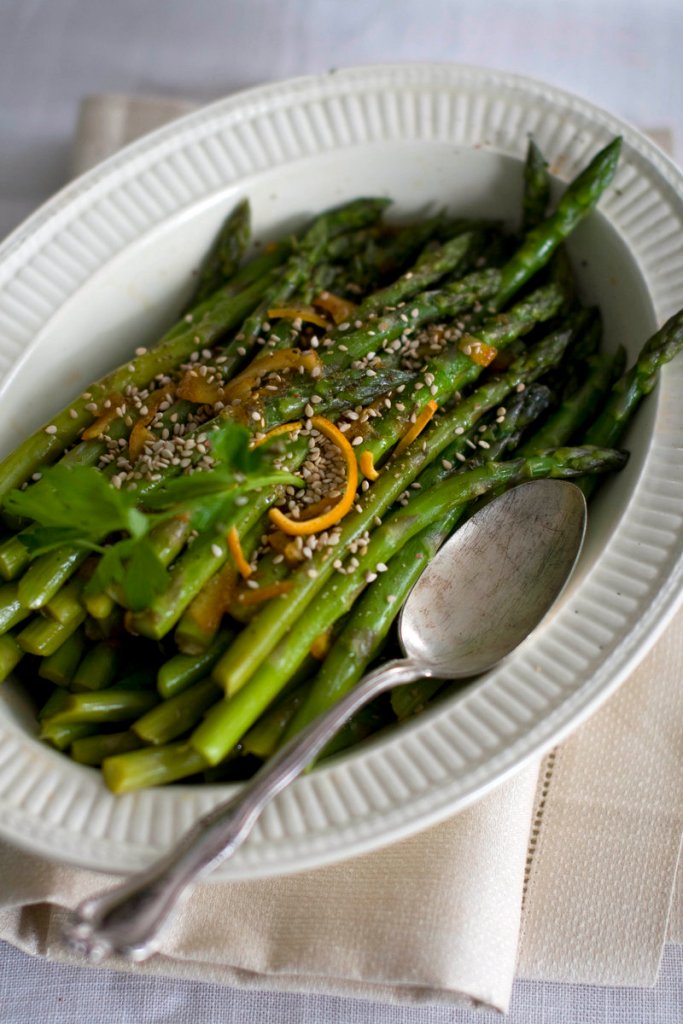In Marcia Pelchat’s family, every festive meal begins with chicken soup. And her grandmother’s sweet-and-sour meatballs.
“We always have chicken soup, even on Thanksgiving, then we have sweet-and-sour meatballs,” says the sensory scientist at Philadelphia’s Monell Chemical Senses Center. “Who knows why. We just learned that they go with Thanksgiving.”
Big holiday meals can be a hodgepodge of unrelated flavors, textures and sensations. The challenge for the host — especially at Thanksgiving, when the sheer volume of food is compounded by deeply held family traditions — is to tie it all together.
So how do you create harmony among otherwise dissonant dishes? The pros suggest threading a single flavor, say sage or citrus, throughout the meal.
“This technique orchestrates the meal,” says Lisa Yockelson, author of “Baking Style,” whose recipes build flavor by using the same ingredient in many forms, for instance, almond paste, almond meal and almond extract together. “The dinner becomes a delicious composite, rather than having to adjust your palate to too many different elements.”
Flavor seems designed to encourage early humans to consume maximum calories in an uncertain world. And the greater the variety of flavors, studies show, the more people tend to eat. But in our modern, calorie-saturated world, well-fed humans have the luxury of rejecting flavors that ricochet from one end of the taste buds to the other.
“You don’t want to confuse your palate,” says Scott Drewno, executive chef at Wolfgang Puck’s The Source, in Washington. “If you’re going to do something with a bracing acid component, like ceviche, is it going to be good on the table with stuffing? They’re at opposite ends of the spectrum and they’re not going to pair well together.”
A single, unifying flavor can end the confusion. But it also presents perils. Pelchat says that unlike the process of “sensory adaptation” — where after a few minutes you become accustomed to an aroma, say dinner cooking — human beings actually perceive a flavor or aroma more acutely when attention is drawn to it.
“It’s like a melody repeating throughout a symphony,” she says.
Citrus “adds brightness, freshness, it accentuates other flavors,” says cookbook writer Michael Ruhlman, author of “Ruhlman’s Twenty.”
Whether it comes from orange, lemon or lime, the acid in citrus fruits balances fat, the way vinegar balances oil in a dressing. It invites salt and awakens the palate. Citrus zest offers bite with its intensely fragrant oils. Used together — as in the lemon-lime sweet potatoes here — the juice and zest create levels of sweet-sour-bitter that play out across your tongue.
“Citrus fruits have a double life,” says Niki Segnit, author of “The Flavor Thesaurus.” “The juice is sour, the zest is bitter. You have two different flavors you can play with.”
Oranges are the world’s most popular citrus fruit, Segnit says, their broad flavor assuring that they play well with most others. Your everyday orange loves apples, fennel and chocolate, but it is so rich in undertones that it also offers surprising combinations, such as our asparagus recipe below.
The sharp, intensely sour juice of limes adds spunk to sugary items, but we often turn to lemons as the workhorse of the kitchen. Their bracing juice highlights almost any flavor, from sweet apple to piney rosemary, and lemon often is what stands between a chef and a one-note dish.
WE’VE FOUND THAT NO roasting technique produces that perfectly browned bird quite as well as a dumping a bottle of soy sauce over the turkey just before popping it in the oven.
So this year we decided to embrace the technique, but elevate it with more sophisticated flavor. We paired the soy sauce with citrus zests. The results were delicious and beautiful. As was the gravy that resulted from the rich pan drippings.
CITRUS-SOY SAUCE TURKEY WITH GRAVY
Start to finish: 3 to 4 hours
Makes a 12- to 14-pound turkey with gravy
10-ounce bottle reduced-sodium soy sauce
2 oranges
1 lemon
12- to 14-pound turkey
2 large yellow onions, quartered
1/2 cup white wine
2 cups reduced-sodium chicken broth
3 tablespoons all-purpose flour
Salt and ground black pepper, to taste
Heat the oven to 350.
In a blender, combine the soy sauce and the zests of both oranges and the lemon. Blend until smooth.
Place the turkey on a rack set in a large roasting pan. Scatter the onion pieces under the rack. Cut the oranges and lemon into chunks and put inside the turkey cavity. Pour the soy sauce mixture all over the turkey and into the cavity of the bird, coating all the surfaces.
Roast for 2 to 21/2 hours, or until the breast reaches 160 F. and the thickest part of the thigh reaches 170 F. If the turkey begins to darken too much, cover with foil.
Transfer the turkey to a serving platter, cover with foil and a couple layers of kitchen towels to keep warm.
Remove the rack from the roasting pan. Use a slotted spoon to remove and discard the onions. Place the roasting pan on the stovetop over medium heat and bring the juices to a simmer. Add the wine and scrape up any browned bits in the pan.
In a small bowl, whisk together the chicken broth and flour. Pour into the pan, whisking constantly. Simmer for 5 minutes, while continuing to stir. For a smoother gravy, you can transfer the mixture to a blender, in batches as needed, and puree until smooth. Season with salt and black pepper.
Serve the turkey with the gravy.
Nutrition information per serving: 490 calories; 200 calories from fat (42 percent of total calories); 22 g fat (6 g saturated; 0 g trans fats); 185 mg cholesterol; 3 g carbohydrate; 65 g protein; 0 g fiber; 550 mg sodium.
CITRUS-GLAZED ASPARAGUS
Trim and steam 2 bunches of asparagus until bright green and just tender, about 5 to 7 minutes. In a small saucepan over medium heat, whisk together 1/4 cup orange marmalade, 2 tablespoons lime juice, 1/2 teaspoon smoked paprika and 1/4 teaspoon cumin. Bring to a simmer, then season with salt and pepper. Toss the asparagus in the glaze and sprinkle with toasted sesame seeds. Serves 6.
Nutrition information per serving: 80 calories; 5 calories from fat (8 percent of total calories); 1 g fat (0 g saturated; 0 g trans fats); 0 mg cholesterol; 16 g carbohydrate; 4 g protein; 4 g fiber; 170 mg sodium.
EASY CITRUS-HERB CRANBERRY SAUCE
Cut 3 clementines in half. Remove any seeds. In a processor, pulse the clementine halves until finely chopped. Add 1 tablespoon chopped fresh thyme, 1 teaspoon chopped fresh marjoram and 1 tablespoon chopped chives. Pulse to mix, then transfer to a bowl and stir in a 14-ounce can whole-berry cranberry sauce. Season with salt and pepper. Serves 12.
Nutrition information per serving: 60 calories; 0 calories from fat (0 percent of total calories); 0 g fat (0 g saturated; 0 g trans fats); 0 mg cholesterol; 15 g carbohydrate; 0 g protein; 1 g fiber; 5 mg sodium.
LEMON-ROSEMARY BREADSTICKS
In a small skillet over medium heat, melt 4 tablespoons of butter with the zest of 1 lemon and 2 tablespoons minced fresh rosemary. Cook for 1 minute. On a lightly floured surface, roll out a 20-ounce ball of purchased pizza dough to a 12-by-18-inch rectangle. Cut into 1-inch strips. Brush with the lemon-rosemary butter, then transfer to a lightly oiled baking sheet, twisting if desired. Allow to rest at room temperature for 20 minutes. Bake for 20 minutes at 350. Serves 12.
Nutrition information per serving: 140 calories; 50 calories from fat (36 percent of total calories); 6 g fat (3 g saturated; 0 g trans fats); 10 mg cholesterol; 20 g carbohydrate; 3 g protein; 1 g fiber; 160 mg sodium.
(Recipes by Alison Ladman)
SWEET POTATOES WITH LEMON-LIME VINAIGRETTE
Start to finish: 1 hour
Servings: 12
5 pounds sweet potatoes, peeled and cubed
3/4 cup olive oil, divided
2 teaspoons salt
1 teaspoon ground black pepper
Zest and juice of 1 lemon
Zest and juice of 1 lime
3 tablespoons honey
2 tablespoons white balsamic vinegar
1/2 cup crumbled or grated ricotta salata cheese or crumbled goat cheese
2 tablespoons chopped fresh chives
Heat the oven to 400.
In a large bowl, toss together the sweet potatoes, 1/4 cup of the olive oil, salt and pepper. Spread over 2 large baking sheets and roast for 30 to 40 minutes, or until tender and browned.
In a blender, combine the remaining 1/2 cup of olive oil, the lemon juice and zest, lime juice and zest, honey and vinegar. Puree until smooth. Arrange the roasted sweet potatoes on a platter, drizzle the vinaigrette over the top. Sprinkle with the ricotta salata or goat cheese and the chives.
Nutrition information per serving: 330 calories; 150 calories from fat (43 percent of total calories); 16 g fat (4 g saturated; 0 g trans fats); 5 mg cholesterol; 43 g carbohydrate; 5 g protein; 6 g fiber; 460 mg sodium.
ORANGE PECAN STUFFING
Start to finish: 45 minutes
Servings: 8
10 ounces sweet or hot Italian turkey sausage, casings removed
1/4 cup white wine
2 tablespoons butter
1 large sweet onion, diced
2 stalks celery, diced
1 teaspoon ground coriander
1/4 teaspoon chili powder
1 teaspoon salt
1/2 teaspoon ground black pepper
1/2 cup diced dried apricots
Zest and juice of 1 orange
1 1/2 cups low-sodium chicken broth
6 cups stale bread cubes
3/4 cup toasted chopped pecans
2 tablespoons chopped fresh parsley
Heat the oven to 350. Spray a large casserole dish with cooking spray.
In a large skillet over medium-high heat, saute the turkey sausage until browned and cooked through, breaking it up as it cooks. Add the wine to the pan and scrape up any browned bits stuck to the bottom of the skillet. Add the butter, onion and celery, then cook until the onion is tender and translucent, about 5 minutes.
Add the coriander, chili powder, salt, pepper, apricots, and orange zest and juice. Continue to cook for 2 minutes to help develop the flavors. Add the chicken broth and bring to a simmer.
In a large bowl, combine the bread cubes, pecans, parsley and meat mixture from the pan. Toss until well mixed. Spoon the mixture into the prepared casserole. This can be done up to 2 days in advance (cover with plastic and refrigerate). Bake for 30 to 40 minutes, or until the top is golden and the center of the stuffing reaches 165 F.
If dried apricots — which add sweetness as well as a pleasant chew — don’t do it for you, feel free to substitute dried cranberries or cherries.
Nutrition information per serving: 300 calories; 140 calories from fat (48 percent of total calories); 16 g fat (3 g saturated; 0 g trans fats); 30 mg cholesterol; 28 g carbohydrate; 11 g protein; 3 g fiber; 690 mg sodium.
Copy the Story Link
Send questions/comments to the editors.





Success. Please wait for the page to reload. If the page does not reload within 5 seconds, please refresh the page.
Enter your email and password to access comments.
Hi, to comment on stories you must . This profile is in addition to your subscription and website login.
Already have a commenting profile? .
Invalid username/password.
Please check your email to confirm and complete your registration.
Only subscribers are eligible to post comments. Please subscribe or login first for digital access. Here’s why.
Use the form below to reset your password. When you've submitted your account email, we will send an email with a reset code.